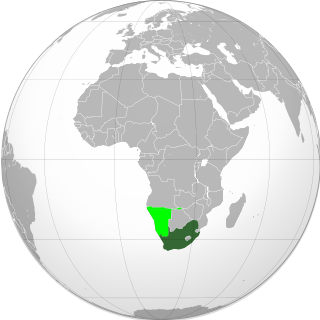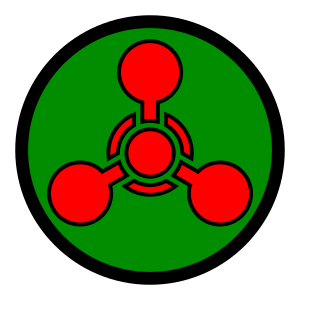Related Research Articles

Biological warfare, also known as germ warfare, is the use of biological toxins or infectious agents such as bacteria, viruses, insects, and fungi with the intent to kill, harm or incapacitate humans, animals or plants as an act of war. Biological weapons are living organisms or replicating entities. Entomological (insect) warfare is a subtype of biological warfare.
Project Coast was a 1980s top-secret chemical and biological weapons (CBW) program instituted by the apartheid-era government of South Africa. Project Coast was the successor to a limited postwar CBW program, which mainly produced the lethal agents CX powder and mustard gas, as well as non-lethal tear gas for riot control purposes. The program was headed by the cardiologist Wouter Basson, who was also the personal physician of South African Prime Minister P. W. Botha.
The All-Union Science Production Association Biopreparat was a Soviet agency created in April 1974, which spearheaded the largest and most sophisticated offensive biological warfare program the world has ever seen. It was a vast, ostensibly civilian, network employing 30–40,000 personnel and incorporating five major military-focused research institutes, numerous design and instrument-making facilities, three pilot plants and five dual-use production plants. The network pursued major offensive research and development programs which genetically engineered microbial strains to be resistant to an array of antibiotics. In addition, bacterial agents were created with the ability to produce various peptides, yielding strains with wholly new and unexpected pathogenic properties.

Porton Down is a science and defence technology campus in Wiltshire, England, just north-east of the village of Porton, near Salisbury. It is home to two British government facilities: a site of the Ministry of Defence's Defence Science and Technology Laboratory – known for over 100 years as one of the UK's most secretive and controversial military research facilities, occupying 7,000 acres (2,800 ha) – and a site of the UK Health Security Agency. Since 2018, part of the campus has housed Porton Science Park, which is owned and operated by Wiltshire Council and has private sector companies in the health, life science and defence and security sectors.

From the 1960s to the 1990s, South Africa pursued research into weapons of mass destruction, including nuclear, biological, and chemical weapons under the apartheid government. South Africa’s nuclear weapons doctrine was designed for political leverage rather than actual battlefield use, specifically to induce the United States of America to intervene in any regional conflicts between South Africa and the Soviet Union or its proxies. To achieve a minimum credible deterrence, a total of six nuclear weapons were covertly assembled by the late 1980s.

Wouter Basson is a South African cardiologist and former head of the country's secret chemical and biological warfare project, Project Coast, during the apartheid era. Nicknamed "Dr. Death" by the press for his alleged actions in apartheid South Africa, Basson was acquitted in 2002 of 67 charges, after having been suspended from his military post with full pay in 1999.

Australia does not possess weapons of mass destruction, although it has participated in extensive research into nuclear, biological and chemical weapons in the past.
The United States biological weapons program officially began in spring 1943 on orders from U.S. President Franklin D. Roosevelt. Research continued following World War II as the U.S. built up a large stockpile of biological agents and weapons. Over the course of its 27-year history, the program weaponized and stockpiled seven bio-agents — Bacillus anthracis (anthrax), Francisella tularensis (tularemia), Brucella spp (brucellosis), Coxiella burnetii (Q-fever), Venezuelan equine encephalitis virus, Botulinum toxin (botulism), and Staphylococcal enterotoxin B. The US also pursued basic research on many more bio-agents. Throughout its history, the U.S. bioweapons program was secret. It was later revealed that laboratory and field testing had been common. The official policy of the United States was first to deter the use of bio-weapons against U.S. forces and secondarily to retaliate if deterrence failed.
Protechnik was a front company established on 24 June 1987 by the South African Defence Force to perform quality assurance testing of chemical protective materials and equipment within a covert operation known as Project Coast.
Delta G Scientific Company was originally a front company established April 1982 in Weldegraan, Pretoria by the South African Defence Force to research and produce chemical weapons within a covert operation known as Project Coast.

The Soviet Union covertly operated the world's largest, longest, and most sophisticated biological weapons program, thereby violating its obligations as a party to the Biological Weapons Convention of 1972. The Soviet program began in the 1920s and lasted until at least September 1992 but has possibly been continued by Russian Federation after that.
The "Statement on Chemical and Biological Defense Policies and Programs" was a speech delivered on November 25, 1969, by U.S. President Richard Nixon. In the speech, Nixon announced the end of the U.S. offensive biological weapons program and reaffirmed a no-first-use policy for chemical weapons. The statement excluded toxins, herbicides and riot-control agents as they were not chemical and biological weapons, though herbicides and toxins were both later banned. The decision to ban biological weapons was influenced by a number of domestic and international issues.

The Biological Weapons Anti-Terrorism Act of 1989 (BWATA), Pub. L. 101–298, enacted May 22, 1990) was a piece of U.S. legislation that was passed into law in 1990. It provided for the implementation of the Biological Weapons Convention as well as criminal penalties for violation of its provisions. The law was amended in 1996 and has been used to prosecute several individuals.

A chemical weapon (CW) is a specialized munition that uses chemicals formulated to inflict death or harm on humans. According to the Organisation for the Prohibition of Chemical Weapons (OPCW), this can be any chemical compound intended as a weapon "or its precursor that can cause death, injury, temporary incapacitation or sensory irritation through its chemical action. Munitions or other delivery devices designed to deliver chemical weapons, whether filled or unfilled, are also considered weapons themselves."
Before the 20th century, the use of biological agents took three major forms:
The Biological and Chemical Defence Review Committee, or BCDRC is a civilian body having oversight of the Canadian military's activities in the area of defence against biological and chemical warfare.
The United States Biological Defense Program—in recent years also called the National Biodefense Strategy—refers to the collective effort by all levels of government, along with private enterprise and other stakeholders, in the United States to carry out biodefense activities.

Although many other countries have possessed chemical and biological weapons programs, Rhodesia was one of the few countries known to have used chemical and biological agents. Rhodesian CBW use took place toward the end of Rhodesia's protracted struggle against a growing African nationalist insurgency in the late 1970s. The genesis of the Rhodesian CBW effort emerged as a result of a deteriorating security situation that developed following Mozambique's independence from Portuguese colonial rule. In April 1980, the former colony became the independent country of Zimbabwe.
Chemical weapons have been a part of warfare in most societies for centuries. However, their usage has been extremely controversial since the 20th century.
References
- ↑ "NTI: Country Overviews: South Africa: Biological Facilities". Archived from the original on 15 February 2007. Retrieved 10 May 2007.
- ↑ "Project Coast: Apartheid's Chemical and Biological Warfare Programme" (PDF). United Nations Institute for Disarmament Research. pp. 77–109. Retrieved 29 October 2018.
25°36′54″S28°21′55″E / 25.61500°S 28.36528°E